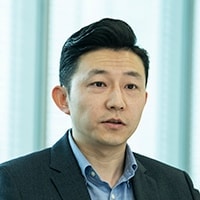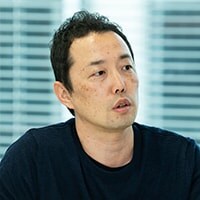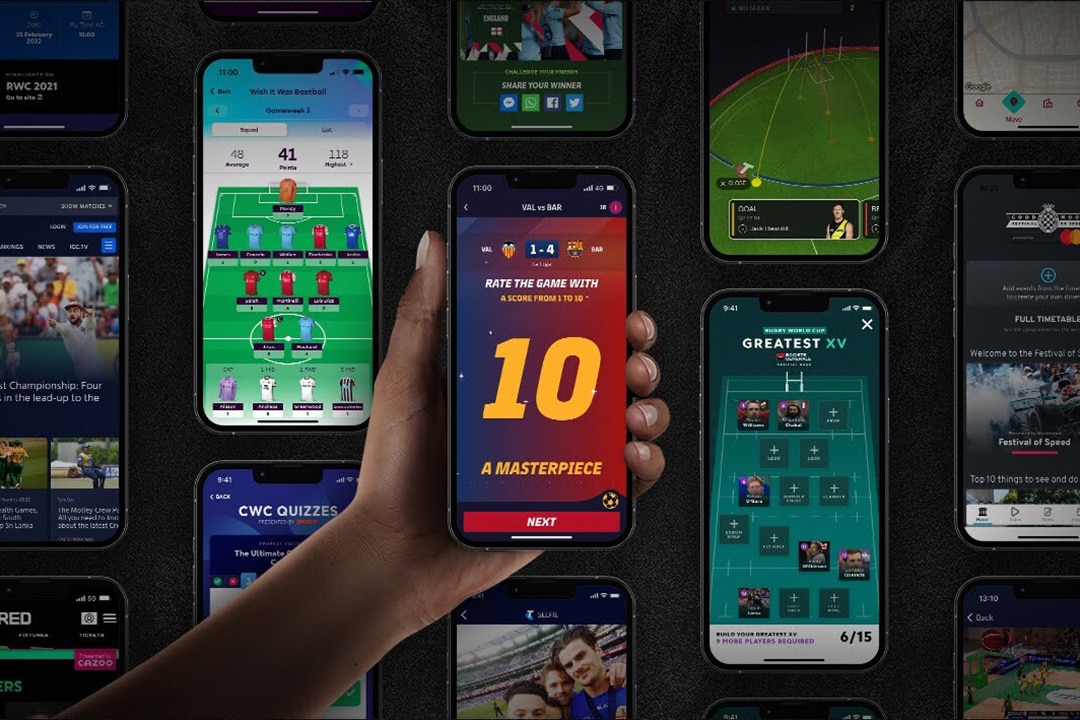Cutting Edge
New Experience Value to be Achievable only by “Sony x 5G”
Jun 28, 2019

Sony’s initiative toward 5G started in 2012. 5G has the characteristics of great capacity, massive connectivity, and low latency, being expected to bring the values of real time (temporal value) and reality (spatial value), and safety and security to the society. How will Sony utilize such 5G technology to deploy its products and services for social implementation? We interviewed Peter Karlsson (Sweden), Chris Clifton (UK), Chen Sun (China), and Ryo Sawai (Japan), who are engaged in 5G standardization.
Profile
-

Peter Karlsson
Research & Standardization,
Sony Research Center Lund -

Chris Clifton
Technology Office,
Sony Semiconductor & Electronic Solutions,
Sony Europe Ltd. -

Chen Sun
Wireless Network Research Department,
Sony China Research Laboratory,
Sony China Ltd. -

Ryo Sawai
Connectivity Technology Development Department,
Fundamental Technology Research and Development Division1,
R&D Center,
Sony Corporation
Current Position of 5G Standardization
──First, let me start by asking, what are your main activities in 5G standardization?”
Ryo Sawai:We participate in the international standardization meetings of 3GPP (Third Generation Partnership Project) where we propose 5G-related communication technologies and contribute to defining 5G technological standards.

Peter Karlsson:About 1000 to 2000 people from more than 100 companies worldwide gather in this meeting—for example, attendees include telecommunications operators, infrastructure equipment vendors, mobile device vendors, semiconductor vendors, and application providers. So, we face many difficulties in having negotiations and getting consensus from main companies by lobbying and socializing. We are sometimes caught in power games, and at other times we see our proposals employed solely because of technological superiority.
Basically, companies holding core technology patents are strong and influential in the meeting, so we put our efforts on trying to persuade them to take on our proposed technology, which is extremely hard work.
──What kind of phase are you in right now?
Chris Clifton:In 3GPP, we finished defining the basic features and functionality (5G Standardization Phase 1) and we have moved on to the standardization Phase 2, where we are working on extending the massive device connectivity aspect of 5G in order to connect trillions of devices and sensors designed for the age of IoT to networks, and enhancing the mobile network functionality for high-capacity communication to stably provide Gbps applications. We are also dealing with the core technology standardization in order to enable 5G-unique application services that will realize ultra-reliable and low-latency communication infrastructure—self-driving cars being one of such use cases.
──Could you tell us when and how did Sony start working on 5G and what roles do each of you assume?
Karlsson:Sony started basic research on the “next generation of 4G LTE” in 2012. We first began joint research with research organizations including universities. And in cooperation with other companies, we submitted our proposal to 3GPP in 2016.
My role was to drive a project of hearing various visions and opinions within Sony regarding what issues we must overcome and what will be our new challenges when Sony is moving forward to the next generation of communications. I organized the collected voices, shaped the ideas into a proposal, and team members attended 3GPP meetings to present it to the companies and research institutes attending there.
Clifton:Myself and my team have been particularly engaged in the telecommunications technology development from the aspect of IoT (Internet of Things), or more specifically, Machine-Type Communication (MTC), which focuses on data transmission without the need for human interaction. In this development, it is very important to drive the 5G mobile evolution so that it builds upon the MTC standards developed during the 4G era.
Here in UK, I started joint research on 5G with University of Surrey 5G Innovation Centre (5GIC), from around 2012. I believe this centre became one of the world’s largest academic-based 5G research initiatives. Sony was a member of the 5GIC founder team together with major mobile operators and equipment suppliers—many other companies joined the 5GIC after 2013. Various research initiatives helped us to move from just the idea level to the stage of drawing clearer visions, allowing us to make important 5G standardization inputs from 2016.

Chen Sun:I also started research into 5G from 2012, and during the research, the entirely new challenges that had never existed, such as massive connectivity or dynamic spectrum access (capability to dynamically allocate frequency resources), confronted us. Now I’m working with four universities and one research institute in China for these themes, focusing on how we can incorporate our research accomplishments into 5G standardization.
Sawai:I have been assigned to work on Sony’s telecommunications research and development and related business since 2002. Sony’s businesses, especially content business, AV device business, IoT business with sensors and other technologies, robotics, and drones, are highly affinitive to the three axes of 5G evolution—great capacity, massive connectivity, and ultra-reliable low latency. 5G is rapidly drawing attention within Sony as more information about the standardized technologies is becoming available to the public. I regard 5G as a social infrastructure that can provide new customer experience value, under the keywords of real time (temporal value) and reality (spatial value) breaking through the limitations of time and space, as well as safety and security.

Great Capacity, Massive Connectivity, and Ultra-Reliable Low Latency
──Standardization is an indispensable process in various technologies, and Sony seems to have played a leading role in many cases, for example, in the video file format and compression technology. How about 5G?
Karlsson:In the case of Sony, it is not simply the matter of smartphones. We have entertainment business, create content, and of course, we manufacture smartphones as well. We have wide-ranging use cases. So, it is important to be able to identify potential use cases and propose them properly on behalf of Sony. In fact, in the 3GPP meetings, we often propose new novel ideas that go above and beyond the expectations or knowledge of other participant companies, and we have a not small presence through such persistent efforts.

Clifton:Yes, that’s right. We are proposing many use cases, and I have a feeling that we are becoming stronger in our position because of that. I recently counted the number of proposals submitted to 3GPP and it was over 650. It seems to me that we have gained a lot of respect from other companies, and we have confidence that we can collaborate with many companies to do various standardization related initiatives together.
Sawai:One of 5G applications that will have great potentiality to be closely related with Sony business is self-driving cars. In the case of collision-avoidance radar systems, for example, an infrastructure is being established so that the driver can predict what is waiting behind the corner from the information transmitted via a 5G network. In this case, the car receives information from the communications infrastructure itself or the cars in proximity communicate with each other for getting information to avoid accidents. Sony can play a key role in this scene using the advantages of its image processing sensors. The image sensor information, especially information about possible dangers detected by feature extraction based on Sony’s high-level image sensor technology, can be shared by self-driving cars directly. China is much advanced in this field. In addition to the self-driving cars, 5G is expected to play an important role in the fields of VR, robotics, and drone, and even in remote surgery.
Sun:And one more thing I’d like to add is gaming. We can enjoy many advantages from 5G’s characteristic, ultra-reliable low latency.
Clifton:Great capacity, massive connectivity, and ultra-reliable low latency will also be a key technology in factories. 5G will be a key enabler of so called “Industry 4.0”, where interconnected machines can function in a coordinated manner at high speed, accurately, and without any errors. Actually, we are currently talking about 5G connectivity for Industry 4.0 with some of our close partners in Europe.
Sawai:When we started working on 5G standardization in 3GPP, we did not have specific operators or vendors, or clear image of new markets or customers in mind. This situation allowed us to some extent to say many things from various viewpoints. In that sense, importance of our voices and existence in 5G seems to be increasing, compared with other standardization processes in the telecommunications area.
──When 5G is standardized, what changes will happen to the society and individuals?
Sawai:If the next generation of communications infrastructure is realized breaking the limitations of time and space, an environment will be available to users where cloud computing, artificial intelligence, sensors, actuators, and robotics will be connected to anyone, anything, anytime, and anywhere through Sony mobile devices and services.
Is the issue “spectrum”!?
──Aside from Sony, how is the reaction of your countries toward 5G? How does your country’s government support it?
Sun:As Sawai-san mentioned, research and demonstration experiments on self-driving cars are largely supported by the government in China. As for the application development based on 5G technology, we are paying attention on how 4K and 8K broadcasting should be supported.

Clifton:As part of the 5G initiatives in UK, the government has been calling for ideas from small and large companies to encourage some particularly compelling use cases. It is expecting that new business and visions are possible with 5G serving as a catalyst. Of course, self-driving cars are a hot topic, too. Aggressive support is being offered to Vehicle-to-X (V2X) since this technology has a real potential to make a massive impact both economically and in terms of safety of the road network.
Karlsson:In Sweden, 5G technology has been understood to some extent, and how to use that technology is being discussed now. The mobile network operators, especially, are demanding killer applications. But, in contrast to 3G and 4G networks where end users are main consumers, I believe 5G will become much more significant when viewed from the BtoB perspective. Factory robots and self-driving cars should become two big pillars in business practically and how to optimize them are being discussed at the moment.
Sawai:In Japan, it is inevitable that labor will be decreased, and at the same time, more people are moving to cities. So, it is important to bring 5G benefits over to areas where communication networks have not so far intervened–for instance, as remote surgery or factory automation.
In the United States, on the other hand, acquiring broadcast content and media content is booming. But there are many locations where optical fibers cannot be laid, and there is growing demand for using 5G to send high-definition video even if there is only a fixed access point available.
In this way, there are needs and characteristics unique to each country, but I think the issue is spectrum, that is, how to allocate new frequency bands. 5G is more flexible to be optimized for a variety of applications, but we will come across another problem, such as “Do telecommunications operators handle the communications infrastructure in factories?” To address this, Japan has started to establish regulations for “local 5G.” Local 5G is a new concept of using high-quality 5G network services locally for our own purposes like Wi-Fi. That means 5G networks will not be limited only to network operators, but will be available to each business or entity. To achieve this, the discussion on how we should allocate frequencies associated with them is going on, and this is a changing point from the discussion so far made on allocating radio frequencies.
Similarly, in the United States, a new concept of “shared spectrum” has emerged and the regulations for it are established. In this concept, it is possible for general users to build their own private networks, even if they are not licensed telecommunications carriers, by using a part of frequency licensed but not used during certain periods or in particular areas. The US is encouraging this new way of using the spectrum as a social implementation, and on this point, it is ahead of other countries. The initiatives driven in this way in Japan and the US are much different from conventional radio laws enacted simply based on the communications technologies.
Characteristics common to Sony’s spirit
──By the way, in the field of communications technology, what history does Sony have and what outcomes did it achieve?
Karlsson:In 1990s, at the start of the digitization of mobile phones (the second generation), Sony entered mobile phone business, developing phones based on the GSM method for the European market and the PDC method for the Japanese market.
After that, when the mobile phones transitioned to the third generation, Sony proposed its own unique method using a system based on Orthogonal Frequency Division Multiple Access (OFDMA) as an international standard. Although the Wideband Code Division Multiple Access (WCDMA) method suggested by other companies was employed and our proposal was not, the basic technology Sony developed then is now widely used in wireless networks, such as LTE and Wi-Fi.
In 2001, Sony and Ericsson started a joint business, launching Sony Ericsson Mobile Communications AB (SEMC), and it took over Sony’s research and development project on mobile phones.
Sawai:From this onward, Sony itself shifted from mobile phones to wireless LAN. At that time, the wireless LAN standards were designed under the initiative of giant American companies in the PC industry, and therefore did not meet the requirements of CE devices. So, Sony cooperated with other Japanese CE manufacturers and initiated the activity to incorporate the required functionality for CE devices to the standards. At this point, Sony was focusing on MIMO (Multiple-Input Multiple-Output), a wireless technology which uses multiple antennas to multiplex radio wave resources into air for higher data throughput. This technology is very important and mandatory in implementing 4G/5G systems today. During the efforts put into this technology, Sony successfully developed its first 802.11n wireless LAN device with Beaming MIMO technique implemented. After that, in 2012, Sony owned SEMC as a wholly owned subsidiary and started again its research and development on mobile phones.
──Before closing the interview, please tell us what is interesting about working in Sony.
Karlsson:Although it is still in the phase of concept, I personally feel the future in the possibility that Sony will contribute to health support through remote operations by monitoring diseases, such as heart disease or diabetes.
Clifton:I have a great interest in immersive entertainment to create new user experience. It might be at the time of 6G or beyond, but what if a virtual form of teleportation is realized as we see in the movie Star Trek? It’s so exciting to have a dream like this and Sony can allow it. It’s good to dream.
Sun:5G connects people to people, people to things, and things to things. In that sense, 5G not only brings revolution to wireless networks, but also contains a factor to transform the society. A new business that never existed may emerge, or people may start behaving differently from they did before. I feel it’s challenging to work for such an area in Sony.
Sawai:As one of the leading technology companies in Japan, I feel great responsibility in standardizing social infrastructure-related technologies and there are high expectations on our such effort. The radio wave resources we deal with are finite, and the activity relating to facilitating efficient utilization or formulating laws and regulations for radio waves brings chances to vitalize the industry and create new business.
5G realizes the communications infrastructure that interconnects people and machines, and its further evolution with great capacity, massive connectivity, and ultra-reliable low latency must be leading to the form of 6G and 7G.
I think the strong will to create such an enormous social change and technology innovation, or ambition to grab it, continuously lives in Sony’s spirit from its foundation.
Sony supports and provides the best environment where we can challenge that globally and collaboratively. That is the uniqueness of Sony and the reason why it is an attractive company to work for.





